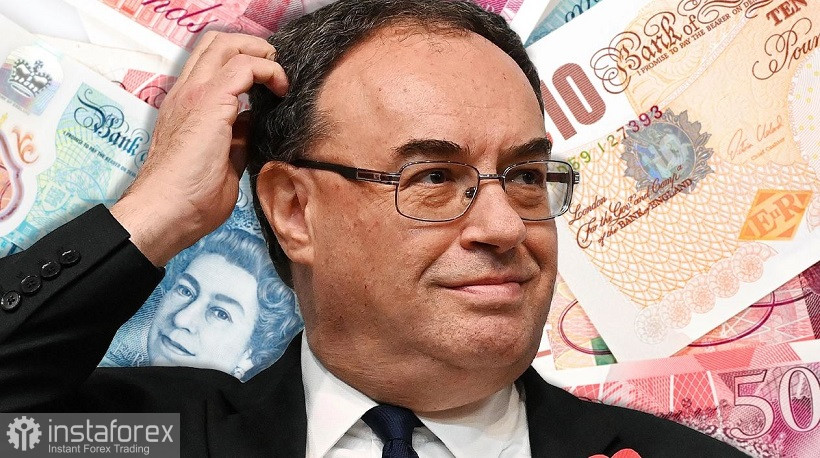The pound-dollar pair reacted negatively to the dovish and indecisive comments of Bank of England Governor Andrew Bailey. A week ago, GBP/USD buyers were approaching the boundaries of the 33rd figure, while yesterday the pair collapsed into the area of the 30th price level. The weakening of the British currency coincided with the strengthening of the dollar, which again began to be in high demand as a protective tool. Geopolitical instability allows dollar bulls to stay afloat, ignoring all other fundamental factors. But the pound could not ignore Bailey's statement.
In my opinion, the pound sterling became a victim of inflated market expectations. The fact is that just last week, fairly strong inflation data were published in the UK, which indicated an increase in price pressure. In particular, the general consumer price index on a monthly basis came out at 0.8%, thereby updating a four-month high. In annual terms, the indicator also showed a jumpy growth, reaching 6.5% (in January, the index was at 5.5%). In this case, we can talk about a long-term record: the indicator showed the strongest growth rate since 1992. Core inflation showed a similar trend. The core consumer price index jumped to 5.2% (this result is also a long-term record).

Here it is necessary to recall the results of the last meeting of the Bank of England, after the announcement of which the pound was under the strongest pressure. Firstly, the regulator raised the rate by 25 basis points, while experts estimated the probability of a 50-point rate increase quite high (35-40%). But the regulator not only failed to meet the "ultra-hawkish" expectations, but also demonstrated a split in the Committee's camp.
BoE Deputy Governor Jon Cunliffe voted against raising the rate, advocating keeping it at 0.5%. The rest of his colleagues supported the next round of tightening monetary policy, but Cunliffe's "dissident attack" alerted market participants. Moreover, traders drew attention to the very cautious wording in the accompanying statement. The text stated that the majority of the Committee members "note the need to tighten policy in order to reduce the risk of sustained inflation growth," however, "the further policy of the regulator will depend on inflation, namely on the dynamics of its growth."
Therefore, the latest inflation release was received with a bang by market participants. Hawkish expectations have increased significantly: the market is increasingly suggesting that the Bank of England will raise the rate to two percent by the end of this year. Against the background of such assumptions, the pound got an opportunity to show character again, having approached the borders of the 33rd figure in a pair with the dollar.
However, after a few days, optimism was replaced by disappointment. Yesterday, Bank of England Governor Andrew Bailey, questioned the expediency of raising the interest rate at the May meeting. During his speech, he pointed out several times the unstable situation that may affect the determination of the members of the regulator. Moreover, in this context, he mentioned not only the "Ukraine case," but also the coronavirus. According to Bailey, the influence of COVID factors on the background of geopolitical instability forces him to be "very careful about the wording of statements of intent." The head of the Bank of England added that now the financial world is "at an even more challenging point for global economy than after the global financial crisis."
In other words, Bailey made it clear that at the moment it is impossible to talk about the May rate hike as "almost a fait accompli." Although this scenario was the basic one for most traders. At the March meeting, the British regulator actually declared further steps to tighten monetary policy, linking this issue to key macroeconomic indicators. However, to date, the circumstances have made their own adjustments: when making a decision on the rate, the BoE will take into account not only geopolitical, but also "coronavirus" factors.
Such a fundamental background puts pressure on the British currency. But at the same time, we must not forget that the GBP/USD pair primarily focuses on the behavior of the greenback, which in turn reacts to geopolitics. The focus is on the negotiations between Russia and Ukraine, which are taking place in Turkey today. It is expected that the parties will make statements this evening or tomorrow morning. The tone of these statements will be extremely important for dollar pairs. If the rhetoric of the parties is optimistic, the greenback will be under significant pressure due to the weakening of anti-risk sentiment in the market. Otherwise, the GBP/USD bears will be able to go to the bottom of the 30th figure and even test the support level of 1.3000.
However, at the moment, both long and short positions on the pair look risky. The information vacuum that has formed in recent days around the Russian-Ukraine negotiation process has allowed GBP/USD traders to switch to Bailey's statements. But in the near future, geopolitics will come to the fore again, overshadowing all other fundamental factors. Therefore, today it is most expedient to take a wait-and-see attitude.





















